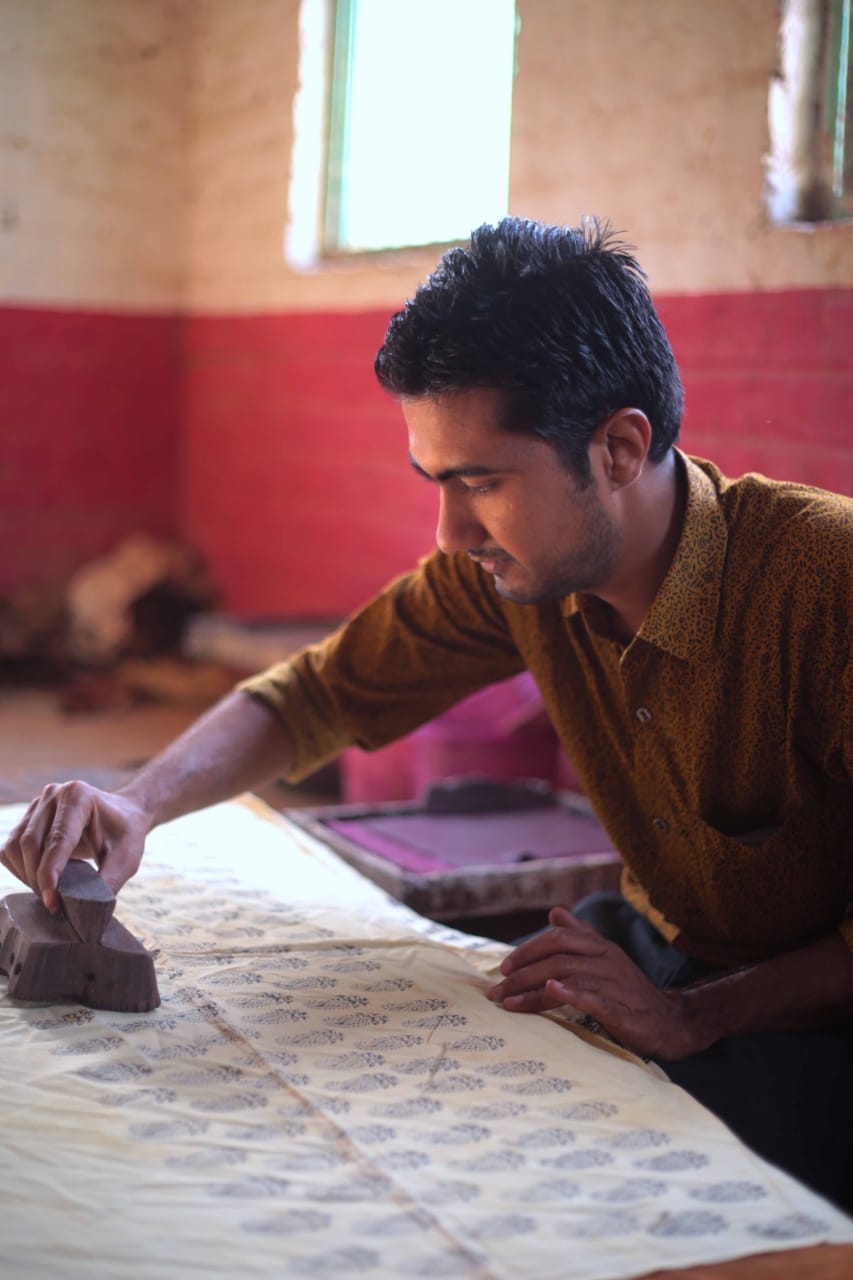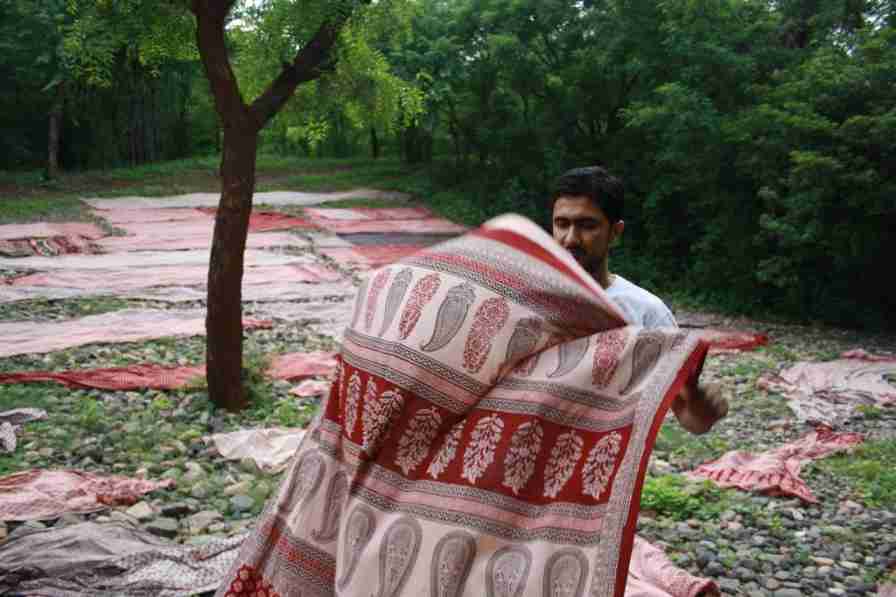Bagh block printing is in yards of trouble
Thousands of yards of the world famous block printed fabrics from Bagh in Madhya Pradesh are languishing for want of buyers. The COVID19 pandemic has hit the business and both artisans and the workshop owners see their hopes fading.


Dhar district’s predominantly adivasi communities do the Bagh printing. All photos: By arrangement
Bilal Khatri has 20,000 metres of Bagh printed fabric in his stock. In the 33-year old’s factory, yards of cloth are block printed using the ancient Bagh block-printing method using natural pigments and dyes.
“Because of the lockdown, I am left with so much yardage. But as the government has given us permission to run the factory, the work continues,” Bilal, who is from village Bagh in Dhar district, Madhya Pradesh, told Gaon Connection. “We cannot ask our artisans not to work, because this is their means of survival,” he added.
On the one hand, the block printing work continues, on the other hand, there is no sale. This has put factory owners like Bilal in a strange situation.“Markets are shut and traders/ wholesale buyers are not coming, and neither have we been able to send anything out,” he lamented.
Also Read: Brimming over with milk, but no takers as COVID19 lockdown impacts dairy farmers

Dhar’s block printing
Dhar district is known for its ancient and traditional block printing technique. The entire process from dyeing of the fabric to the printing is by hand.
Dhar district’s predominantly adivasi communities do the Bagh printing. There are nearly 25 villages that are famous for Bagh printing including Aagar, Udiyapura, Mahakalpura, Ghatbori, Baki, Kadwal predominantly Pipri and Raisinghpura. The artisans sometimes travel to their place of work from as far as 20 kilometres away.
In the days before the pandemic and lockdown, nearly 200 artisans worked in Bilal’s factory, producing bales of Bagh printed fabric. But not all of them are able to come on account of the lockdown, he said.
The second wave of the COVID19 lockdown has seen states imposing fresh lockdowns. In Madhya Pradesh, the lockdown has been extended till May 31 in several districts. In Dhar it is till May 24.
Also Read: Preyed on by the pandemic
“Traders who took the block printed cloth from me have not been able to make their payments because of the slowdown in business and shutting down of shops,” Bilal lamented.

Artisans affected
Thirty-nine-year-old Umar Farakh Khatri once had 15 artisans working for him at Bagh. Now only four or five of them are working in his workshop.
“We continue to print, but very little as only a fraction of my workforce is turning up to work,” he told Gaon Connection. If an artisan works from 9 am to 5 pm, he earns anything between Rs 400 and Rs 500, Umar explained. “We have a stock of ten thousand metres and nothing is moving. Even the online sales are dull,” he said.
“Because of the lockdown and the fear of police apprehending them, many artisans are reluctant to come for work,” Umar continued. Those who come to work from other villages have no transportation, so how will they get to Bagh, he asked.

What is distressing is that between the months of March and May is when a bulk of the work is carried out in preparing the Bagh print fabric. And these are the very months when the pandemic has shown a surge.
“These are hot months. There is no moisture in the air and there is sharp sunshine to dry the printed cloth,” explained Bilal. “We cannot carry out the block printing work in the rainy season as the colours will run and smudge,” he said.
Devi Singh has been a block printer for years. The 40-year-old lives in the village of Mahakalpura, very close to Bagh. “Since my village is just next door, I cycle to Bagh. But not everyone lives so close by,” he said.
According to Devi Singh, there is work all year through, but the crucial months where there is a lot to be done are between March and May. That is when people come from far and near to help out. “But this year, and even last year, not many showed up because of the lockdown,” he told Gaon Connection.

Rising cost of raw materials
According to the directorate of handlooms and handicrafts, there are approximately 14 big and small factories in the district where the work happens where nearly 1,300 blocks are being used to print the fabric. Only natural dyes are used in the printing process.
National award winner, Mohammad Yusuf Khatri has been associated with Bagh printing since he was 10 years old. “In all my life, I have not seen this kind of loss that I have witnessed in the past year,” the 54-year-old told Gaon Connection. “The price of raw material has gone up, but the price of the finished product has gone down in the market when we want to sell it,” he complained.
Yusuf said that while the prices of the raw materials needed for the printing has gone up by nearly 30 per cent, they are being forced to sell the printed cloth at the old rate of Rs 30 a metre while it should be about Rs 52 a metre.
“While the government has not put any restrictions on us as far as work goes, what is the point of production if there is nowhere to sell,” he asked.
Reiterating what Bilal had said, Yusuf told Gaon Connection that stopping the artisans from coming to work was not an option. “They depended on their earnings to run their families,” he pointed out.
“I have nearly seventy lakh rupees worth of fabric lying unsold with me,” Yusuf said. And there was barely any sale happening online, he added.
Also Read: 80% rural respondents said their work was affected due to the lockdown

“For instance if I want to sell material worth twenty lakh rupees online, I will only manage to sell worth thirty thousand rupees,” he continued. His Bagh prints would travel as far as Chennai, Ahmedabad, Mumbai and Kolkata, but all that has stopped. Even the smaller traders who would buy from him have not bought anything this year.
“I have been doing Bagh printing since my childhood. We lost business in last year’s lockdown. It has been just over a month since the lockdown this year. But if this continues longer, only God above can help us,” Yusuf said in resigned tones.
According to Yusuf, Bagh print was already losing its shine for the people who dealt in it. Last year’s lockdown was a catalyst for many others to give it up. “If this carries on, we will lose the traditional craft of Bagh block printing,” he warned.

